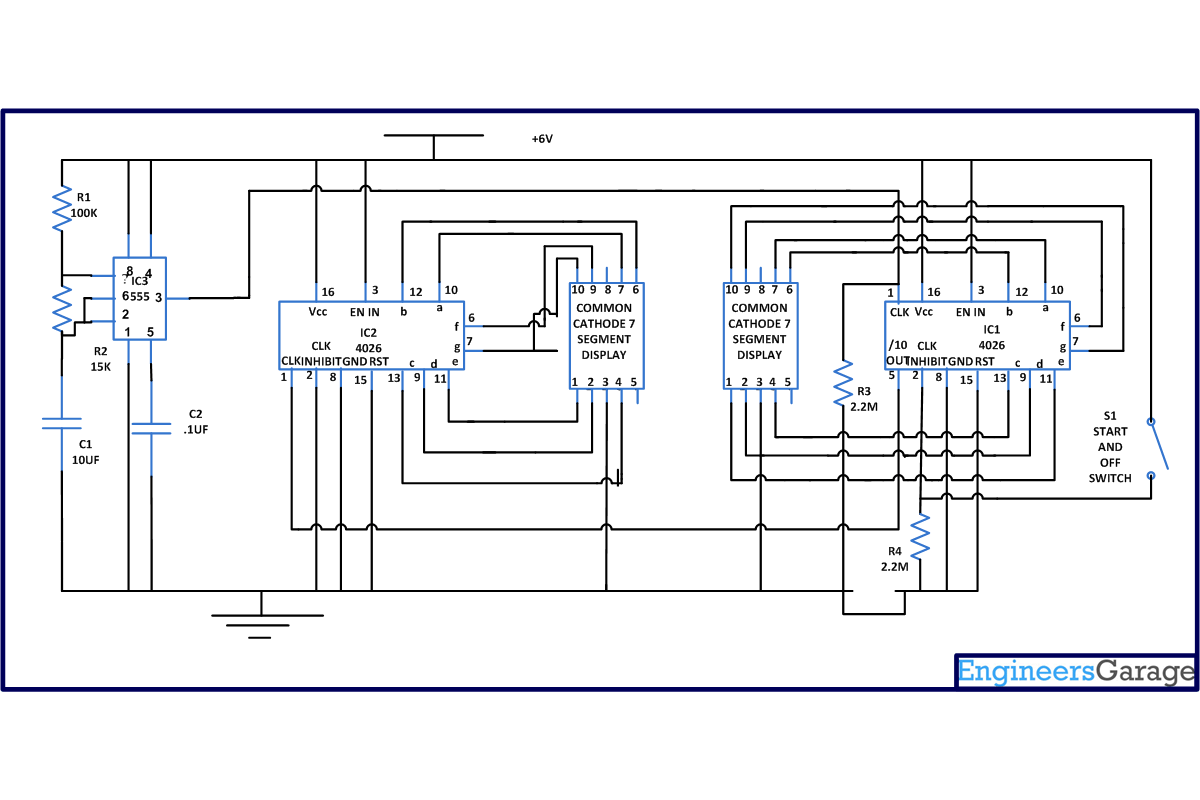The number guessing game is quite simple. In this game the player thinks any number between 1 to 99 and then if same number is displayed on screen, he wins otherwise player looses the game. This simple circuit is based on two IC's namely NE555 which is a timer IC. In this number guessing game circuit we are utilizing it astable mode. And another one that we are using is 4026, which is a decade counter/divider IC. It converts the input into numeric display without any decoder IC which can be seen on 7 segment display.
In this number guessing game circuit, NE555 astable generates a clock for the circuit, which provides a oscillating wave to the output pin 3 of IC1. The time period of counter can be calculated by following formula :
T = 0.7 (R1 + 2*R2)*C1.
Assemble the circuit properly as shown in circuit diagram. Connect the pin 3 of both the IC1 and IC2 to supply, to on the display. If pin 3 is connected to ground we will not get display on 7 segment output. Also connect the pin 15 which is a reset pin to ground so that when counting reaches to 99 it will reset the counter to zero. Lastly, connect the pin 2 to ground if this pin is held high then counter will not advance. Now apply power supply. Zero will be displayed on both the 7 segment display. And counter starts counting by receiving pulse from IC3. As NE555 is wired in astable mode it is generating continuous pulses which make the clock pin1 of IC1 high after every specific period of time. After receiving the clock pulse, 4026 IC counter advances and 1 will be displayed on common cathode of 7 segment displays. When second pulse is encountered it will again make the pin 1 of IC1 high and 2 will be displayed and similar phenomenon occurs till count reaches 9. When it reaches 9, one cycle is completed. As you can see from circuit diagram, pin 5 is a divide by 10 output pin means after every 10 input pin 5 goes high. This property can be utilized to connect more numbers of 4026. In short we can cascade many 4026 to increase the number of 7 segment display.
That’s why we have connected the pin 5 of IC1 to pin 1 of IC2 to cascade another IC, after every 10th pulse it will go high to provide a clock pulse to IC2 to advance its counter, therefore we will receive a 1 on 7 segment common cathode display2 . Unit place number are displayed on display1 and tens place numbers are displayed on display2. After completion of each cycle, tens place advances one. Similarly you can add N numbers of 4026 IC with 7 segment display. Cover the display and ask everyone who are playing to assume a number. Switch on S1 and when anybody says stop, switch off S1. See the number displayed on the screen, if same number is there which a player has assumed then he or she has won the game otherwise lost the game. In this you can also vary the speed of numbers which are displaying on 7 segment display by using a variable resistor in place of R2 in the range from 5K to 50K. 4026 IC is very sensitive to atmosphere you can also utilize this feature just remove the NE555 IC and add a wire at pin 1 of IC1. Touch this with your finger and you will see that counter has advanced and you can play. Try using it on other applications.
Circuit Diagrams
Project Components
Project Video
Filed Under: 555 Timers, Electronic Projects
Filed Under: 555 Timers, Electronic Projects



Questions related to this article?
👉Ask and discuss on EDAboard.com and Electro-Tech-Online.com forums.
Tell Us What You Think!!
You must be logged in to post a comment.